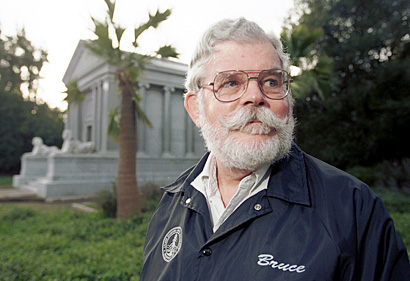Stanford Report, Jan. 14, 2004
Unofficial university historian and Medical Center softball league scorekeeper to be honored at a reception Thursday
BY BARBARA PALMER
Bruce Wiggins, who will retire from Facilities Operations on Thursday after three-and-a-half decades, can't remember a time when Stanford wasn't part of his life.

As a former Stanford
Historical Society board member, Bruce Wiggins maintained the key
to the Mausoleum, where the Stanford family is interred. It was his
job to unlock the tomb every Founder’s Day. Campus
archaeologist Laura Jones said Wiggins is “more of a Stanford
mascot than the tree” and “tells a great story.”
Photo: L.A.
Cicero
The son of botany professor Ira Wiggins, his first direct connection to campus was in 1931 when he started kindergarten at the elementary school that once stood on Mayfield Avenue -- "wearing a 'Hoover for President' pin in my sweater buttonhole," he said.
Although Wiggins has put in 35 official years of service at Stanford, his work record stretches back nearly seven decades. In 1937, during a field trip to the Mojave and Sonoran deserts with his father, he earned a quarter for each lizard and snake specimen he collected. In high school, he earned 50 cents an hour labeling herbarium specimens, and as a Stanford student, Wiggins earned room and board working as a student fireman, was a hasher at Encina Hall and Lagunita Court, and worked in the stockroom at the University Press. After a stint in the U.S. Army Signal Corps, Wiggins earned a bachelor's degree in English in 1948 and went into the fire service for two decades. Still, he stayed in touch -- as Santa Clara County fire marshal for 17 years, he conducted campus fire safety inspections and fire investigations.
Wiggins came to work here full time as manager of facilities safety planning in the midst of student demonstrations against the Vietnam War. (On his second day of work in 1969, students stormed a Board of Trustees meeting at the Faculty Club.) Over the next few years, Wiggins recalled, experience taught him the safest way to deliver messages to noisy protesters: Keep his fingers circled between his mouth and the bullhorn so that his lips wouldn't be crushed when students smacked his bullhorn. On the day in 1971 when students took over the campus computer center, Wiggins smelled smoke and realized that it was coming from him. The lapel of his sports jacket was smoldering from a lit cigarette someone had inserted under his tie.
Over the years, Wiggins also has worked as operations manager of plant operations and as manager of special houses, including the Hoover and Hanna houses; served as liaison with the university and campus leaseholders; and worked as associate director and acting director of operations and maintenance and, most recently, as work systems manager for Facilities Operations.
"Bruce treats the campus and its buildings like his own home," said Alan Cummings, a facilities services manager for Facilities Operations, who was here in 1969 when Wiggins started work. "He always has time for people and always wanted to do the best he could to provide service."
Wiggins' interests outside of work also have centered on Stanford -- he is a former Stanford Historical Society board member and for decades was the keeper of the key to the Mausoleum where Jane and Leland Stanford and their son, Leland Jr., are interred. It was Wiggins' job to unlock the Mausoleum every Founders' Day.
"He's a walking historical source," said Marv Herrington, who was campus police chief from 1971 to 2001. "He really has a sense of the history of the place."
"I can't believe he's leaving," said Laura Jones, campus archeologist. "In my mind, he's more of a Stanford mascot than the tree. Bruce is a fount of Stanford oral history -- and he has a sense of humor about it. He tells a great story."
Because of his passion for Stanford history, "Bruce has done a better job than most people of trying to leave what he knows behind," Jones added. "He's very careful, if he thinks he knows something important, to make sure it isn't lost." As Wiggins works to clear out his packed cubicle in his Bonair Siding office, he is dividing stacks of materials into two streams: One goes to the recycling bin and one will go to University Archives.
For 24 years, Wiggins also has been an institution on the Medical Center's slow-pitch softball league. Three nights a week, from the end of May to September, Wiggins serves as scorekeeper. He also publishes The SUMC Softball Sentinel newsletter, under the slogan: "A Voice for Campus Co-ed Slow Pitchers & Hard Hitters."
"He's kind of been our pillar of strength out there on the softball field," said softball "commissioner" Leander Robinson, supervisor of the electrical shop in the engineering and maintenance department at the Medical Center. "He's a generous, kind-hearted man. He keeps us all straight."
Although Wiggins is leaving his job, he's not retiring as scorekeeper or hanging up his association with the Stanford Historical Society. His wife, Elizabeth Mann McMurray Wiggins, a sister, an aunt, one daughter and a son are all Stanford alumni, and Wiggins has two-ticket season passes to football, men's and women's basketball, and women's volleyball games.
He also plans to continue his annual practice of photographing the Nolina matapensis, a succulent-like arborescent that grows in the Inner Quad. It's likely that the lone specimen growing in the Quad comes from seeds or live plant material collected by his father in Mexico 70 years ago, Wiggins said.
"There are piece of Bruce everywhere," said Robert Carpenter, associate director of Facilities Operations and Wiggins' current boss. "He's touched a lot of people -- he's touched their hearts especially."
Facilities Operations will honor Wiggins at a reception Thursday afternoon.
![]()
